► Mercedes G-Class at the Schöckl
► The mountain where it was born
► A visit inside the G-Wagen factory
We’re balanced in mid-air, a front wheel dangling uselessly from a drooped suspension arm a foot off the ground, the other three tyres squished firmly into the flinty mountainside at an improbable angle: 2.4 tonnes of metal walking a tightrope between see-saw and slip, weight transfer and traction. It’s much steeper than anticipated, I realise, as I step down from the leather-clad cabin and immediately lose my footing, much to photographer Justin’s amusement, suede brogues struggling for grip where the G-Class has resolutely found purchase.
CAR has brought the new G-Class home, to the Schöckl mountain, Mercedes-Benz’s answer to Jeep’s Rubicon Trail or Land Rover’s Eastnor Castle 4×4 playground. Criss-crossing a treacherous mountainside outside the Austrian city of Graz, this patchwork of trails climbs to 1350 metres and includes sections with 45° – or 1-in-1 – inclines.
Read our full Mercedes-Benz G-Class review
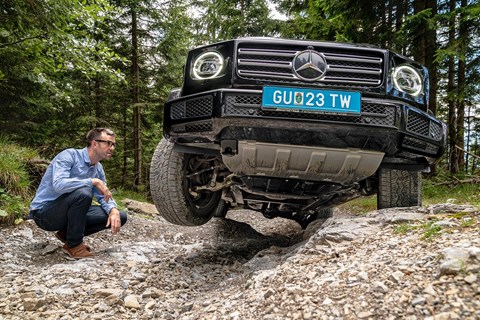
The badge on the B-pillar of the new 2018 G-Class proudly proclaims ‘Schöckl proved’, and we couldn’t resist putting this marketing spiel to the test. The first right-hand-drive models arrived in UK dealerships in summer 2018, fresh off the production line at Magna Steyr in Graz, the brawny off-roader’s home since its birth in 1979. The latest model feels altogether more pampering than earlier, more utilitarian G-wagens: huge digital widescreens dominate the dashboard, motors whirr you into position and massage your buttocks, while electro nannies take over so many driving decisions that you’re reminded autonomous driving really isn’t very far away.
Any fears that this newfound luxury may have compromised the Merc’s mountain-goat skills are quickly quashed as I climb back inside, check all three diff locks are engaged, select Drive and tip-toe forwards. After a few inches, we flip-flop the other way, arcing gracefully to ground our airborne wheel. We’re on one of the Schöckl’s steepest sections, clambering up a narrow path of smooth granite slabs weathered by centuries of mountain rain, wind and foot traffic, dressed in loose rocks and stones so sharp they’ll slice a sidewall in a jiffy. No wonder they keep half a dozen spare tyres at a mountainside cafe near the summit.
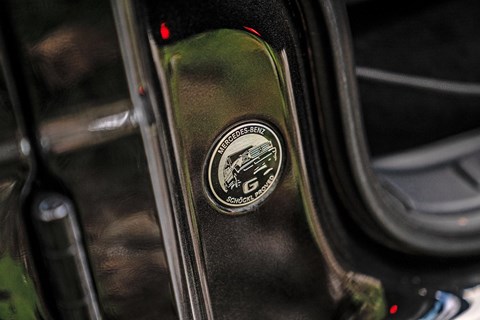
A tickle of throttle and the G crawls up, unfazed by the harsh environment underfoot, those blistered front indicators bobbing up and down as the suspension soaks up every rut and boulder. Mercedes-Benz proudly proclaims that the G-Class is the only production car on sale with three lockable differentials and a low-range transfer case; in low gear the control and steady thrust are nigh-on unstoppable. We’re in the G500, whose 4.0-litre twin-turbo V8 produces a not-inconsiderable 416bhp and (more importantly) 450lb ft of the twisty stuff. Short on grunt it is not.
This engine isn’t offered in right-hand drive yet, although the UK importer is keen to correct that. Right now, Brits can only buy the full-beans G63 AMG with its nutty 577bhp, 4.5sec 0-62mph time and equally spectacular £143k price tag, but a more sensible G350d diesel is under development for launch in 2019.
Merc G350d diesel review
In fact, when we encounter a convoy of three future models on test up the Schöckl I notice one is a right-hooker prototype with the new straight-six oil-burner; it sounds remarkably un-diesely to these ears. Magna engineers run durability tests up here 12 hours a day in two shifts, starting at 6am and pounding the trails to see how the cars hold up to mountain abuse. Each prototype will complete around 1200 off-road miles over three months, regardless of the weather conditions. (‘Up to 20cm of snow is no problem; we can do 40cm with snow chains.’)
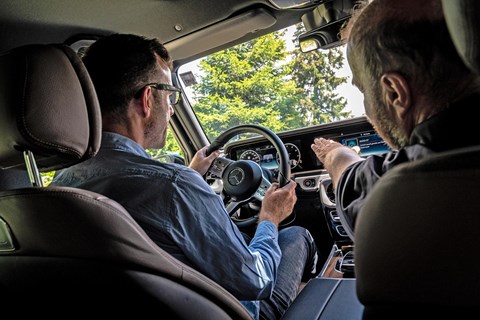
It sounds like a fun job for outward-bound types – and so it proves, according to senior development engineer Max Kniepeiss (above), who joins us for our run up the hill. ‘I reckon I spend 120 working days a year up here – it beats being in an office!’ he beams. And as I survey the panorama from the peak, I’m inclined to agree. Manicured green Austrian farmland stretches before us, mountain bikers and paragliders gaming the gradient, the more serious Alps rising ominously in the distance.
The tinkle of cow bells and ripe brown deposits underfoot at the top of the Schöckl explain the succulent meat we’ve enjoyed for lunch and contrast with the heavy industry of car manufacturing back on the valley floor in Graz, whose 280,000 inhabitants go about their business, lorries, buses and cars scuttling like ants along the urban road network below.
‘The mountain is one giant rock: it’s stayed the same for centuries, so it’s great for us to benchmark how cars perform up here – we can compare test results going back decades,’ says Kniepeiss, a Magna veteran who started work on all-wheel-drive Cavaliers and Pandas 29 years ago. ‘The rocks are really sharp up here, they can easily destroy tyres. The G-Class could do the Schöckl on road tyres, but we’d be forever changing punctures, so we use tough all-terrain tyres for testing.’
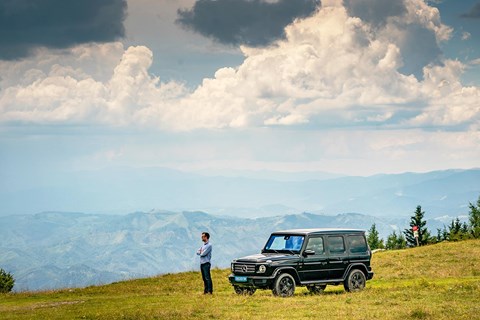
The Falken Wildpeaks are huge, apocalypse-spec rubber, wrapped around the G’s smallest 18-inch alloys, their deep grooves sniffing out traction on every surface we encounter. They also destroy the ride quality; the G’s usually serene progress on road rubber becoming somewhat fussier on the more aggressive treadblocks. But the 500 retains the new G-Class’s composure in daily use; this is an altogether more rounded proposition than the outgoing G-Class, which remained on sale little changed from 1990 until this year’s replacement (confusingly still codenamed 463 in Merc-speak). The set-square design may be intact but the entire platform is new, including the ladder-frame steel chassis that lends the car the strength it needs to conquer mountains, motorways and Metroland alike.
Only three parts are carried over: the old-school door handles that shut with a wonderful ker-clunk, the headlamp washer jets and the spare wheel cover on the hilariously perpendicular, side-hinged tailgate. Mercedes has done a fine job of replicating the familiar bluff silhouette, but look closely and you’ll notice this one is subtly modernised. The drag coefficient is an improbably brick-ish 0.54 but they’ve paid extra attention to streamlining the windows and rain gutters to make the car quieter, and inside there’s noticeably more room. Your elbows will no longer be burrowing into the door card.
That whopping great big grab handle sprouting from the dashboard comes in handy as Kniepeiss asks to drive back down the mountain. Seems the test drivers like to play a little game in this off-road paradise: it might as well be called Bobsleigh Run By G, or How Implausibly Fast Can We Drive Downhill In Two-And-a-Half Tonnes Of 4×4, as he hammers down the steep track I’ve just crawled up, sawing away at the wheel, pogoing over rocks like a Dakar rally raid special at faintly ridiculous speeds. At one point, I glance across the dash and struggle to compute the 70km/h (44mph) reading as we plunge on down the steep trail, great plumes of dust billowing in our wake. This descent alone convinces me this is an impossibly strong car.
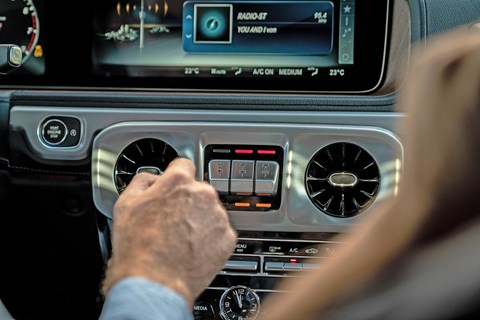
Back on metalled roads, the G brushes off this moment of muddy madness and – differentials unlocked, high range selected, radio switched from rock ’n’ roll to Mozart – mooches along rural Austrian B-roads for all the world like a slightly taller, squarer E-Class. The grunty G500 gushes forward at the merest tickle of your right foot, its V8 burble more everyday-enjoyable than the OTT histrionics of the shrieking AMG G63.
As the miles click by, I’m reminded just how well the new G steers, stops and goes. The outgoing model was a caricature: plenty of gung-ho swagger but the actual business of driving, especially around corners, was one full of anxious moments.
There’s no hand-wringing here, as this most dual-purpose of 4x4s cruises home. Key to its improved on-road behaviour are two significant engineering changes for the new-generation G: electrically assisted rack-and-pinion steering in place of the old car’s lethargic recirculating-ball set-up, and double-wishbone front suspension. Together the two have comprehensively modernised the G-Class driving experience.
We’re headed for the colossal Magna Steyr facility in the Liebenau district, the company’s European HQ and home to some 8000 staff. It’s the car industry’s go-to place when manufacturers’ own factories run out of capacity, and from 2019 it will build the new Z4 for BMW; today it assembles the BMW 5-series plus the i-Pace and E-Pace for Jaguar and the G for Merc. This is the longest-lasting relationship Magna has, and the G’s been in continuous production here since 1979. The 300,000th car rolled off the line last year, and they reckon more than three-quarters of the Gs built are still on the road today.
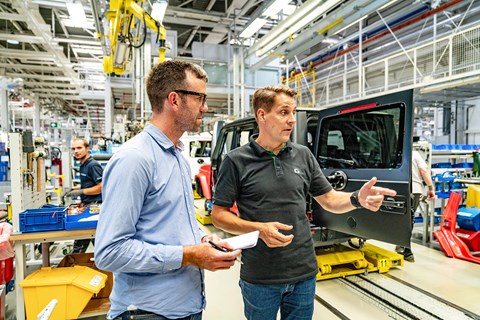
We’re met by the head of Mercedes-Benz G GmbH, Dr Gunnar Güthenke (above), who’s agreed to give CAR a guided tour. His is a boutique manufacturing division hived off into a 100 per cent Merc subsidiary, a muddy skunkworks tucked away in the foothills of the Austrian mountains. Mercedes has a team of 250 specialists in Graz, working alongside 2000 Magna employees who built 22,000 G-classes last year.
‘This is a hand-built car and around a quarter of our customers have their cars personalised,’ says Güthenke as we tour the 27,600 square-metre facility on an electric golf cart upgraded with hand-stitched leather seats made by the same craftspeople who assemble the G-Class’s hand-made pews.
‘Our takt rate [the speed at which a car comes off the line] is one every 10 minutes, whereas in a normal car factory it is around 60-70 seconds per car. It takes 140 hours to make a G-Class.’ Those six-figure price tags are perhaps not so ludicrous after all…
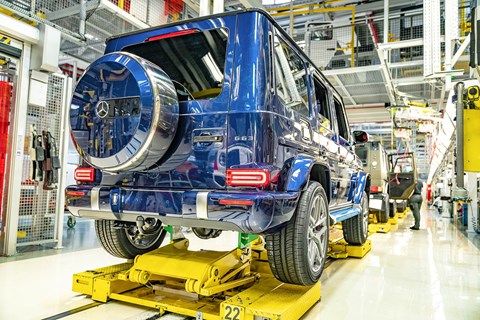
Cars crawl along the line at a snail’s pace, components, dashboards and wiring looms gradually added by hand (we spot only one robot, for accurately gluing windscreens in place), the alchemy of manual production mesmerising to watch as crates of parts slowly become whole cars.
The G-Class is unusual in having different generations of the same product going down a single line; they still manufacture the old 461 model for military and non-civilian duty, and we see these workhorses inching down the line, looking impossibly cool in their tougher, textured camo paint. ‘You can stand on it in army boots and it won’t crack,’ says Güthenke.
And in a corner of the factory we spot a couple of bombproof versions. ‘We sell a 5.4- and a 6.2-tonne ballistic option,’ he adds. ‘You can put six kilos of TNT under one and you will walk away. You might be scratched, but you will survive. We don’t yet offer this option on the new car, the 463.’

The older 461 is like a Lego toolkit, according to the boss, and it’s this model that’s sold to armies, fire brigades, the Red Cross and other heavy-duty services in the world’s toughest environments. They can bolt on single-cab or double-cab bodies, tin-top or soft-top roofs, 4×4 or 6×6 drivetrains – it’s like a Rubik’s Cube, endlessly swivelled to create ever more outrageous shapes and meet every conceivable civic duty, whether your job is extinguishing fire or raining it down on an unseen enemy.
Güthenke becomes guarded when discussing customers but admits they supply the Swiss and German armies. ‘We have to be discreet,’ he admits, refusing to be drawn when I ask about rumours they’re talking to the British MoD.
You sense the G-Class doesn’t play by the normal rules. It’s a halo car for Mercedes-Benz, and it’s no accident they roll out fleets of them at events like London Fashion Week. It mixes catwalk cool with the kind of mud-plugging muscle that only the toughest of off-roading enthusiasts will ever appreciate.
In a corner of the reception hall, we spot a faded photo of current group chief executive Dieter Zetsche at Graz in his time there as chief engineer in the ’90s (see below). This flagship has connections right to the top of Daimler, which might explain how the huge investment required for this ground-up relaunch got sanctioned.

It can’t have been cheap to develop that new ladder-frame chassis, and those bulbous indicators – which now meet pedestrian safety regs by popping down like bubble-wrap in an impact – are ‘five times more expensive than conventional indicators’. It’s this long-term thinking that should see the G-Class through another 40 years, and Güthenke admits the platform is ‘ready for electrification’.
For now, an e-G is not a priority. Around 22,000 wealthy, mucky and ostentatious customers around the world pick this car for its ability to take them places other cars can’t, and to do so in style, with lashings of luxury, and often at speed – and to hell with the fuel consumption.
Merc doesn’t break down the revenues and profits of the G business. But consider the government contracts (which can run to hundreds or even a few thousand G-Classes), the lucrative G63 (£143k) and those occasional madcap spin-offs (the last 6×6 sold cost €479,000 – or £427k – a pop), and you quickly conclude that the G-Class business is in fact underscored by surprisingly sound financials.
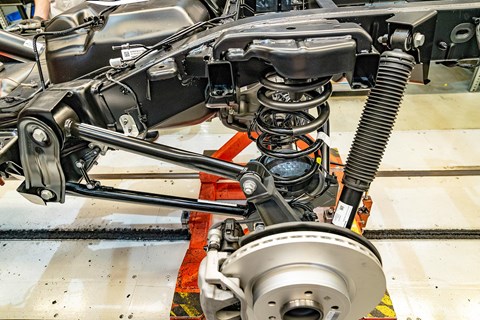
Our time in big boys’ Tonka toy heaven is nearly over. The new G-Class was never going to fail its test up the Schöckl, but after a day driving the latest iteration up and down mountains, burbling along country roads and inspecting its innards on the factory floor, I’m mightily impressed nonetheless.
Forget the raft of luxe new SUVs launching left, right and centre from Lamborghini, Rolls-Royce and the rest – there’s only one supercar of the off-road world as far as I’m concerned. And it’s gnarly, gregarious and great with a capital G.
All our Mercedes-Benz reviews